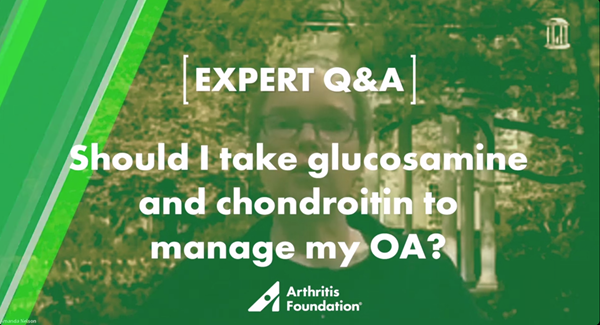Glucosamine and Chondroitin for Osteoarthritis Pain
Research is mixed on whether these supplements help with OA pain and stiffness, but they are safe to try.
Glucosamine and chondroitin are popular supplements used to treat osteoarthritis (OA). According to one estimate from the National Institutes of Health, 6.5 million adults, or 2.6% of the population, has used one or both of these products. Although studies on glucosamine and chondroitin have been mixed, some evidence suggests they may help relieve OA joint pain and stiffness.
What Are Glucosamine and Chondroitin?
Glucosamine and chondroitin are natural compounds found in healthy cartilage — the connective tissue that cushions joints. Supplements are manufactured from the cartilage of animals such as cows, pigs or shellfish, or are made in a lab. Glucosamine is sold in different forms, including glucosamine sulfate and glucosamine hydrochloride. You can buy glucosamine and chondroitin individually, but most often they’re sold together in a single supplement.
In many European countries, these supplements are a prescribed treatment for OA. In the U.S., the recommendations on glucosamine and chondroitin are more moderate, due to the mixed results of studies.
How Do They Work?
In OA, the gradual degeneration of cartilage leads to pain, swelling, and other symptoms. Glucosamine and chondroitin have anti-inflammatory properties. “They also have some cartilage-protecting effects through a variety of different mechanisms,” says Chris D’Adamo, PhD, director of Research & Education at the University of Maryland School of Medicine Center for Integrative Medicine.
Glucosamine and chondroitin protect cells called chondrocytes, which help maintain cartilage structure. In theory, these supplements have the potential to slow cartilage deterioration in the joints, and to reduce pain in the process.
The Evidence
The most comprehensive long-term study — the Glucosamine/Chondroitin Arthritis Intervention Trial (GAIT) — compared the combination of glucosamine hydrochloride and chondroitin, both supplements individually, celecoxib (Celebrex) and a placebo (inactive pill) in nearly 1,600 people with knee osteoarthritis.
The first phase of GAIT, published in 2006, found that the combination of glucosamine and chondroitin sulfate didn’t offer significant relief to participants in general, but it did help a small subgroup of those with moderate-to-severe knee pain. In follow-up results of the study released in 2010, these supplements improved pain and function, although no better than a placebo or the NSAID drug celecoxib.
Since the GAIT trial came out, a few large studies have shown more positive results, says D’Adamo. “If you look at the totality of the evidence for glucosamine and chondroitin for osteoarthritis of the knee, it’s very strong.”
A 2016 multinational study called the MOVES trial found the combination of glucosamine and chondroitin as effective at relieving knee OA pain and swelling as celecoxib, without the side effects. The authors say these supplements could be a good alternative for people who aren’t good candidates for NSAIDs because they have cardiovascular or GI conditions. And another 2015 study found the combination helped reduce joint space narrowing — a sign of cartilage degeneration.
Reviews of studies have yielded mixed results about these supplements. Some found the supplements offered pain relief and function compared to placebo, while others didn’t. The difference in outcomes may be due to the variety of supplement types and doses researchers used.
Which Form Is Best?
Studies have also differed on which of these supplements offers the greatest benefit for OA. Some find chondroitin to be superior, others favor glucosamine, while still others prefer a combination of the two. “Evidence would favor the two,” D’Adamo says. “They’re typically bundled that way when you buy them.”
The ideal form of glucosamine has also caused dissent in the research community. Some studies show an advantage to glucosamine sulfate; others to glucosamine hydrochloride. One study that compared the two glucosamine forms head to head found no real difference between them.
“There are some studies that show improved joint flexibility and range of motion with glucosamine sulfate,” says Farshad Fani Marvasti, MD, MPH, director of Public Health, Prevention, and Health Promotion at The University of Arizona. “That’s the one I would take if you’re going to take it for joint stiffness.”
Mayo Clinic researchers agree, saying that evidence supports trying glucosamine sulfate — not hydrochloride — with or without chondroitin sulfate for knee OA.
Are They Safe?
Glucosamine and chondroitin are considered safe, with no serious side effects reported in studies. However, these supplements can interact with blood thinners like warfarin (Coumadin).
They might also affect blood sugar levels, and one small study found they raise eye pressure, which could increase the risk for glaucoma. If you have diabetes or glaucoma, you may need to avoid these supplements, or have your doctor monitor your blood sugar levels and eye pressure more closely while you take them.
The Bottom Line
In 2019 OA treatment guidelines, the Arthritis Foundation and American College of Rheumatology give a conditional recommendation of chondroitin sulfate for hand OA. The National Center for Complementary and Integrative Health (NCCIH) says the evidence on glucosamine for OA pain is unclear, and chondroitin isn’t helpful, but that these supplements haven’t been shown to be harmful. That means that there isn't strong evidence that benefits outweigh risk, but the supplement could be helpful for people with OA.
If you do want to try glucosamine and/or chondroitin, check with your doctor and pharmacist first to make sure it’s safe for you, and that it won’t interact with any other drugs you take. Also, be patient. “It can take weeks for the effectiveness to fully manifest,” D’Adamo says. “That differs from an NSAID or COX-2 inhibitor, where the relief is fairly immediate, but side effects are much more common.”
Around the clock and all year long, we’ve got you covered with unique pain management tools and resources you won’t find anywhere else.
Stay in the Know. Live in the Yes.
Get involved with the arthritis community. Tell us a little about yourself and, based on your interests, you’ll receive emails packed with the latest information and resources to live your best life and connect with others.



